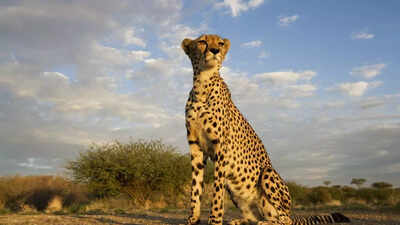- News
- Science News
- Scientists set to bring back extinct Indian cheetahs with gene technology after reviving dire wolves
Scientists set to bring back extinct Indian cheetahs with gene technology after reviving dire wolves
Following dire wolf resurrection success, Indian scientists are striving to revive the extinct Indian cheetah. Utilizing advanced gene-editing and cloning, the Birbal Sahni Institute of Palaeosciences and the Zoological Survey of India are collaborating to sequence the cheetah's genome. The plan involves implanting Indian cheetah genes into African cheetahs for surrogacy.
Following the successful reintroduction of the once-extinct dire wolves, scientists have set their sights next on reintroducing another mythical creature—the Indian cheetah. Selecting the world's fastest land animal, the cheetah was declared extinct in India in 1952 because of over-hunting and habitat destruction. Now, most of the world's cheetah population lives on the African continent, with the vast majority residing largely in South Africa, Namibia, and Botswana.
Scientists to resurrect Indian cheetah after dire wolves
After the success of Colossal Biosciences in resurrecting the dead dire wolf with the help of ancient DNA, gene-editing, and cloning techniques, Lucknow's Birbal Sahni Institute of Palaeosciences (BSIP) has joined hands with the Zoological Survey of India (ZSI) to resurrect the Indian cheetah. The project is at its last stage of whole genome sequencing (WGS), an important stage that will allow scientists to study the cheetah's entire DNA composition. This will allow them to identify genetic differences that might have led the species to extinction, i.e., disease susceptibility.
The WGS process will take three months, says BSIP project leader and senior scientist Niraj Rai. Upon completion, the team would be able to sort out the Indian and African cheetah genomes, allowing for genetic changes that would enable African cheetahs to inherit traits specific to their Indian ancestors.
Revival plan for Indian cheetahs
The plan for the revival of the Indian cheetah has another solution: surrogacy. Indian cheetah genes will be implanted in the womb of an African cheetah in a way that animals with Indian cheetah characteristics are born. The practice is as close to Colossal Biosciences' efforts to bring back the dire wolf pups, first of all which were revived by genetic method as well. When the genetic alterations have been established, the offspring will hold the characteristics of the Indian vanished cheetah, thus returning the species to their native habitat.
Indian-born cheetahs do not yet exist, but reintroduction has already begun. A few cheetahs were introduced in 2022-2023 from Namibia and South Africa to India. The cheetahs were relocated to Kuno National Park in Madhya Pradesh, where they are being acclimatized to the Indian climate. As per reports, the number of cheetahs in India has increased to 26, including 14 cubs born on Indian soil, a great milestone in the cheetah reintroduction program.
Extinction of Indian cheetahs
Cheetahs were well-distributed throughout India in the past, but during the 20th century cheetah populations were miserably diminishing. The final blow was delivered in 1947 when Maharaja Ramanuj Pratap Singh Deo poached and slaughtered the last three identified Asiatic cheetahs at Chhattisgarh. And from then on, after that, the Indian government officially announced the species extinct in the year 1952.
The Indian cheetah population deteriorated due to a variety of reasons. The main reason was hunting, but loss of habitat and prey also led to their extinction within such a short span of time. With no food and space to survive, the population of cheetahs could not survive.
Future of the Indian cheetah
Though the reintroduction process itself is still nascent, advances in genetic studies and cloning technology and continued African cheetah relocation to India give one reason to hope that the Indian cheetah shall soon be reintroduced into its original habitat not too distant from now. The research conducted at BSIP and ZSI can be the first step towards introducing the species into India's ecosystem again so that future generations get to see the Indian cheetah's speed and agility once more.
Also Read | Lyrid meteor shower peaks on Tuesday - Know the best time to watch the breathtaking fireballs on April 22

About the Author
TOI Science DeskEnd of Article
Follow Us On Social Media

